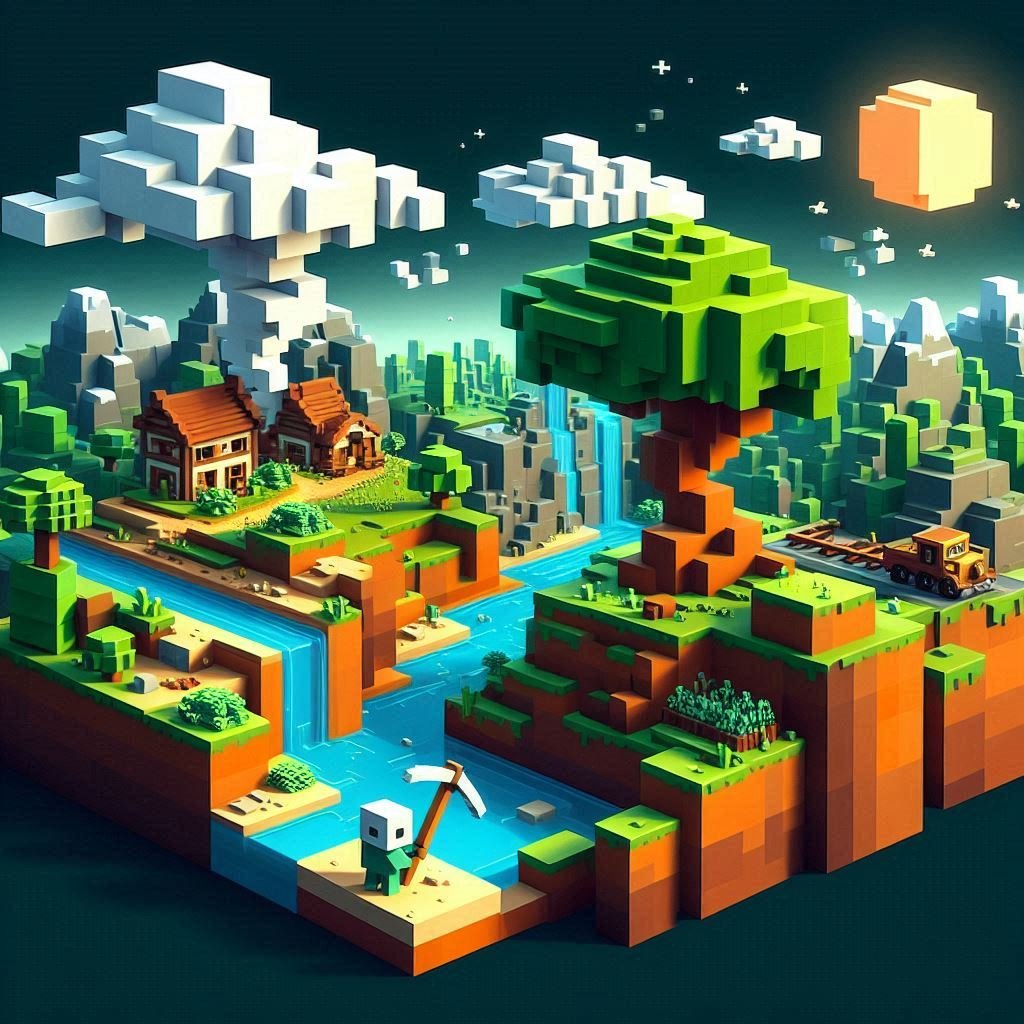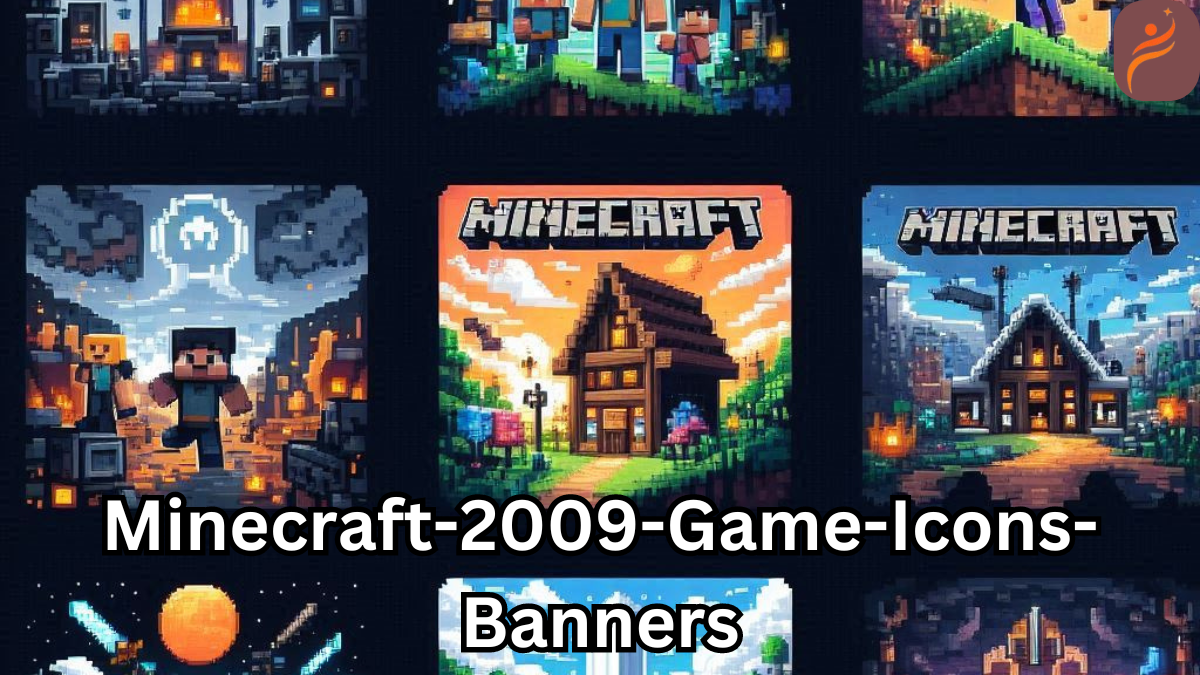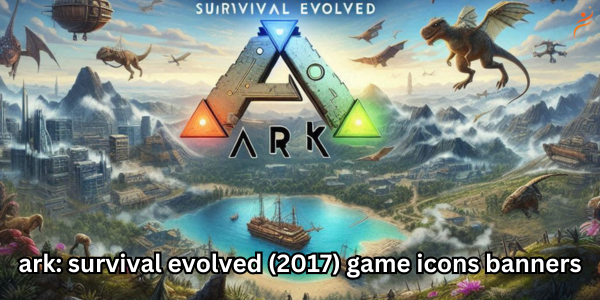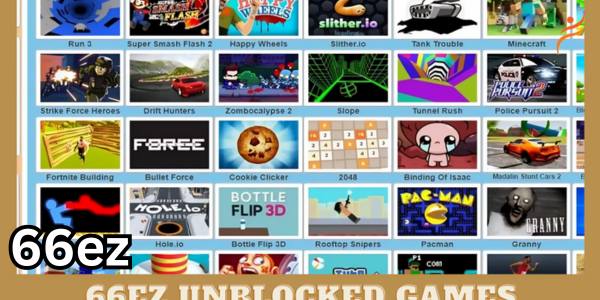Minecrafts, the iconic sandbox game developed by Markus “Notch” Persson and later acquired by Mojang Studios, has left an indelible mark on the gaming industry. Since its release in 2009, the game has evolved significantly, influencing a wide range of media, including game icons and banners. These elements play a crucial role in representing and promoting the game across various platforms. This article delves into the evolution of Minecraft game icons and banners, focusing on their impact from the game’s early days to the present.

The Birth of Minecrafts: 2009 and Its Initial Icons
The Genesis of Minecrafts
In May 2009, Markus Persson released the first public version of Minecrafts. The game was initially known as “Cave Game” before being renamed “Minecrafts: Order of the Stone” and finally “Minecrafts.” The early version of Minecrafts was minimalist, reflecting Persson’s vision of a simple, block-based sandbox game.
Early Game Icons
The earliest Minecrafts icons were simple and rudimentary. The first icon, which appeared on Minecraft’s website and launcher, featured a pixelated, blocky representation of the game’s logo. This simplicity matched the early visual style of the game, which consisted of basic 3D cubes and simplistic textures.
Significance of the Early Icons
The early icons and banners served a dual purpose: they represented the game’s visual identity and communicated its innovative concept. Despite their simplicity, these early graphics captured the essence of Minecraft’s blocky aesthetic and laid the foundation for future design elements.
The Evolution of Minecrafts Icons
Transition to a More Polished Look
As Minecrafts gained popularity, the need for a more polished and recognizable icon became evident. The transition from the basic pixelated design to a more refined and professional look marked a significant evolution in the game’s visual identity. The new icons incorporated elements like the classic grass block, a recognizable symbol for Minecrafts.
Icon Variations Across Platforms
Minecraft’s growing presence on various platforms, including PC, consoles, and mobile devices, led to the creation of different icon versions tailored to each platform. For instance, the Java Edition icons featured the classic block design, while the Bedrock Edition icons showcased a more modern and sleek appearance. These variations helped maintain consistency while adapting to platform-specific requirements.
Icon Updates and Branding
Over the years, Minecraft’s iconography underwent several updates to align with the game’s evolving branding and aesthetic changes. The updates included changes in color schemes, texturing, and overall design to reflect the game’s growth and the introduction of new features. Each iteration aimed to enhance recognition and appeal, ensuring the icon remained relevant in an ever-changing gaming landscape.
The Role of Banners in Minecrafts
Introduction to Banners
In Minecrafts, banners are customizable items used for decoration and identification. Introduced in Minecrafts version 1.8, banners allow players to create personalized designs using various patterns and colors. Banners serve as a means of self-expression within the game, providing players with a creative outlet to showcase their individuality.
Banner Design Mechanics
The mechanics of banner design involve a combination of dyes and patterns, enabling players to craft unique designs. The use of different colors, shapes, and patterns allows for an extensive range of customization options. Banners can be used in various ways, including as flags, shields, or decorative elements in player-built structures.
Impact of Banners on Minecraft Community
Banners have had a significant impact on the Minecraft community, fostering creativity and collaboration. Players often share their custom banner designs within the community, leading to the creation of numerous design templates and patterns. The ability to customize banners has become a beloved feature, adding a layer of personalization to the Minecraft experience.
The Impact of Minecraft Icons and Banners on Branding
Branding and Recognition
Minecraft’s icons and banners have played a crucial role in shaping the game’s branding and recognition. The evolution of the game’s visual identity reflects its growth from a niche indie project to a global phenomenon. Consistent and recognizable icons and banners help reinforce the game’s brand identity and maintain a connection with its audience.
Marketing and Merchandising
Icons and banners are essential elements in Minecraft’s marketing and merchandising efforts. The game’s visual elements appear in promotional materials, merchandise, and various media channels, contributing to its widespread recognition and appeal. The iconic grass block, for instance, has become synonymous with Minecraft, appearing on a range of products from toys to apparel.
Community Engagement
The design of Minecraft icons and banners also plays a role in community engagement. Custom banners created by players often feature prominently in fan art, community events, and online forums. The ability to personalize and share designs fosters a sense of community and ownership among players, strengthening their connection to the game.
The Future of Minecraft Icons and Banners
Evolving Design Trends
As Minecraft continues to evolve, its icons and banners will likely undergo further changes to reflect new design trends and technological advancements. The incorporation of modern graphic techniques and adaptive designs will ensure that the game’s visual elements remain fresh and engaging.
Expanding Platforms and Media
With Minecraft expanding to new platforms and media, the need for adaptable and versatile icons and banners will grow. Future iterations may include dynamic elements, interactive features, and cross-platform consistency to maintain a cohesive visual identity across various platforms.
Continued Community Involvement
The Minecraft community’s involvement in creating and sharing custom banners will continue to play a significant role in the game’s visual landscape. The collaborative nature of banner design fosters creativity and innovation, ensuring that player-generated content remains a vibrant and integral part of the Minecraft experience.

FAQs
1. What is Minecraft, and when was it first released?
- Answer: Minecraft is a sandbox video game developed by Markus “Notch” Persson and later acquired by Mojang Studios. The game was first released to the public on May 17, 2009. It features a block-based world where players can build, explore, and survive.
2. What were the original icons for Minecraft in 2009?
- Answer: The original Minecraft icons in 2009 were simple and pixelated, reflecting the game’s early minimalist design. The first icons featured a blocky representation of the game’s logo, which included a basic grass block.
3. How did Minecraft icons evolve over time?
- Answer: Minecraft icons evolved from simple pixelated designs to more polished and recognizable graphics. Early icons used basic block designs, while later versions incorporated the iconic grass block and other elements to better represent the game’s branding across different platforms.
4. What are Minecraft banners, and when were they introduced?
- Answer: Minecraft banners are customizable decorative items that players can create using various patterns and colors. They were introduced in Minecraft version 1.8, released on September 2, 2014. Banners can be used for decoration, identification, and personalization within the game.
5. How can players customize Minecraft banners?
- Answer: Players can customize Minecraft banners using dyes and patterns. By combining different colors and shapes, players can create unique designs. Banners can be customized with up to 16 different patterns and colors, allowing for a wide range of personalization options.
Conclusion
The evolution of Minecraft icons and banners since 2009 reflects the game’s growth and its impact on the gaming industry. From its humble beginnings with basic pixelated icons to its current polished and diverse visual elements, Minecraft’s icons and banners have played a crucial role in shaping its brand identity and engaging its community. As the game continues to evolve, the future of its visual elements will undoubtedly embrace new trends and technologies, ensuring that Minecraft remains a beloved and iconic part of the gaming world.



